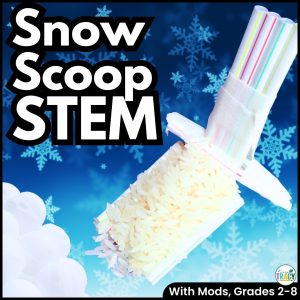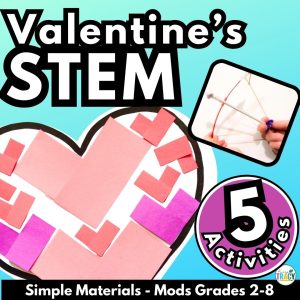Winter Break goes by too fast, doesn’t it?! By now, you’re either already back in school or getting pretty close. I hope your break was restful, joyful, and rejuvenating! Because I don’t want the rest of your winter to feel long & dark, I’m creating a couple of new challenges to keep the enthusiasm for learning up this semester! Snow Scoop is the first!
Premise
In Snow Scoop, students essentially build a snow shovel, designed for maximum capacity and/or maximum efficiency. Success can be evaluated in one or both of the following ways: largest possible scoop capacity or time to clear a 1-inch path in the snow (or to clear the entire yard of snow).

Materials for Snow Scoop STEM Challenge
The list of materials you’ll need is short and easily modified, making this Winter STEM activity simple to incorporate with very little need for additional prep. You’ll need:
- Snowy Yard
~ 12in. X 8 in. x 2 in. pan or box lid
2 lb. bag of white rice or 1 bag of mini marshmallows - Paper plate or bowl (to hold the snow from scoop designs for weighing)
- Craft sticks (3-5)
- Straws (3-5)
- Pipe cleaners (3-5)
- Masking tape (12 – 24 in.)
- 3×5 in. index card (1)
- Scissors
- Scale (if choosing the capacity challenge goal)
- Stopwatches (if choosing the time to clear snow challenge goal)
- Design analysis handouts
Optional Materials
- Binder clips
- Clothespins
- Rubber bands
- String

Where Can I Find Out More?
As you may already be aware, I’ve found creating video walk-throughs of my STEM challenges is the best way to explain the important details: materials, set-up, tips, modifications, extensions, and more! Check out the video below to learn more about Snow Scoop. However, if you prefer to read, you’ll find the video transcribed at the end of this post.
Are There Other Winter STEM Challenges Like This?
Of course! I can’t help myself! You’ll find all five of the Late Winter STEM challenges I’ve created in the 5-challenge bundle briefly described in this post. Each challenge post is linked there for the walk-through videos and more details. You can also find this Winter STEM activity alone (top left) or in a bundle of 5 Late Winter STEM activities (top right). You may also like the Valentine’s Day STEM Activities Bundle & the St. Patrick’s Day STEM Challenge Activities Bundle. Please reach out with any questions and tag me in photos of your students’ work on Facebook & Instagram if you want to give me a smile this winter season!
You can also find this Winter STEM activity, Snow Scoop, on Etsy!
Related Posts
Video Transcription
Hi there! Welcome to the very first video of the brand new year. Happy 2017! Since this is the first video, let’s just talk a little bit about what’s coming soon. So, I do have a brand new challenge for you today as I promised a couple of weeks ago. For sure I have another brand new winter challenge coming as well. I’m gonna try to get that out by next week, January 12th, but I’m not gonna promise it.
If it’s not out by the 12th, it will be out by the 19th. Following that, I’m gonna get straight into the Valentine’s Day STEM Challenges, and then it’s Saint Patrick’s Day, Easter, Earth Day, and then I have some really great summer STEM Challenges coming for you as well.
So the challenge for today is Snow Scoop. It’s essentially a snow shovel that the students are designing with a few tweaks. But, before I get ahead of myself, let’s check out the materials and the STEM Challenge Cycle.
This is the STEM Challenge Cycle you should follow for every challenge. I’ve defined each step in another video. I’ve added a pop-in card to that video here, as well as a link in the description.
1:02
There are a couple of options to set up the yard and the snow. So, for the yard what you see here is about a 12 inch by 8 1/2-inch pan. And you can also just take a cereal box and just cut off the top. You do need to tape where the box opens. Another option is just to take a gift box lid and separate those out and give each student one half of the box.
As far as the snow goes you can see here I’ve used mini-marshmallows. And you might have some left over if you did the Frozen Fortress Challenge, or if you’re going to, you can double up. In this tray I’m using rice as my snow, and that is my favorite to use. You can use basically anything you want. Confectioner’s sugar, salt, confetti. For confetti, there’s no need to buy anything. Just empty out the contents of your three-hole punch and maybe ask a couple of your teacher friends down the hall to do the same, and you’ll have what you need.
1:51
I strongly recommend doing this challenge with partners and not in groups. The reason for that is the designs are going to be pretty small, so if you have four students trying to work on one snow scoop at a time, there’s just really not enough for everybody to be able to stay engaged. On the flip side, you could do this as an individual challenge, but I find I enjoy having a partnership there, because the students can still bounce ideas off each other, and get all those benefits of collaboration.
I start the criteria and the constraints pretty simple on this one. Basically the students have to design a scoop that efficiently moves snow and is operated with only two fingers on one hand. Now, I can choose whichever ones, and I don’t distinguish the thumb from the rest of the fingers.
Just a note about the two finger constraint, so trying to sort of manage for the scale issue. This is a snowy yard, and these are snow shovels. If we allow students to build snow scoops that are maybe as big as their two hands, not only would it blow the scale way out of proportion because you wouldn’t have a snow scoop half the size of your yard. And it would also not be something realistic that a person could operate in their own yard, because the amount of snow it would lift would be far too heavy. I will demo each of these snow scoops in just a couple seconds.
3:00
You have a couple of different options here for how you can measure results. The simplest way to measure the efficiency of the snow scoops is to take one single scoop and the students will be aiming for as much snow as possible. So, the largest single scoop. Definitely let the students take turns so that each of them gets an opportunity to use the snow scoop.
Another way to measure results is a little more challenging. You can treat this again, as a snowy yard, and the students have to clear a one-inch path from end to end. Now, in this case, they’ll be measuring not the weight of the snow, but the amount of time it takes to clear the one-inch path.
So, what you can do is either give students timers, or if you have a projector in your room, and you have internet access, you can go online, just search online timer, and you can set it off at the same time. And since the students will be in partners, one can be keeping an eye on the clock. Do allow the students to switch roles. Because it’s a lot more fun to scoop the snow than it is to watch the clock. And in that case, they can either average the two times, or they can take the better of the two.
4:35
Okay, so if you want to make this easier, then you can remove the constraint that they are only allowed to use two fingers on one hand. Either make it two fingers on two hands, or just remove that constraint altogether.
So, a few ideas to make the challenge more difficult. I just came up with this one as I tried to use the snow scoop with my left hand, which is not my dominant hand. It was much more difficult. So, one thing you can do is to add a constraint that they have to use their non-dominant hand in order to scoop the snow. You can change the challenge goal to be clearing the entire yard of snow. But, you’re gonna have to have some extra time if you want to do that. You can remove the index card from the materials and you can either require or constrain certain shapes, whether that be polygons or 3D solids.
To extend on this one, this is a great opportunity to study levers and classifying them into first class, second class, or third class.
5:23
So, not all snow is exactly the same. Some of it is more dense, some of it’s more hard-packed, some of its lighter and fluffier. So, you can repeat this challenge with different types of snow and see if the same shovels work best in each of those different types. What you’ll probably find is that some perform
better in some types of snow versus others. From there you can use that as a jumping off point to talk about cell specialization and organelles and how they’re formed specially to do their special jobs.
And of course, you can have students graph their data and even whole class data.
So, you have everything you need in order to do this on your own. But, I always give you extras and goodies in the resource, so check it out.
6:02
Save some time, this resource contains everything you need, including modifications for use with 2nd through 8th graders. You’ll still need to gather the simple materials, of course, but the hard parts are done. You’ll get Aligned Next Generation Science Standards, links to my STEM Challenge How-To videos to help you get the most from each challenge, and the Snow Scoop Materials List.
In Teacher Tips you’ll find premise and setup, how to increase or decrease difficulty through the criteria and constraints list, measuring results, and cross-curricular extension suggestions. You’ll find an editable Criteria and Constraints list so you can tailor the challenge to your students.
For Student Handouts, there are two versions. Four-page expanded room for response for younger students, and a two-page, condensed space, paper saver version. You’ll also find a set of group discussion questions. In the Extension Handouts, you’ll find classifying levers, notes and practice with answer key, comparing snow shovel lever classifications, as well as math extension and process flow templates.
This resource is available individually, and as part of the Mega STEM Challenge Bundle. Links can be found in the description below the video.
I have a special New Year’s request from you. If you are doing these challenges in your classroom, and you’re already posting on social media pictures of the student’s designs, I would love to see them, please tag me. It brings me so much joy, and I have all my social media linked in the description below.
With that, I hope you are off to an excellent new year. Don’t forget to Like and Subscribe. I will see you next week. See ya next time.
Pin Me!






